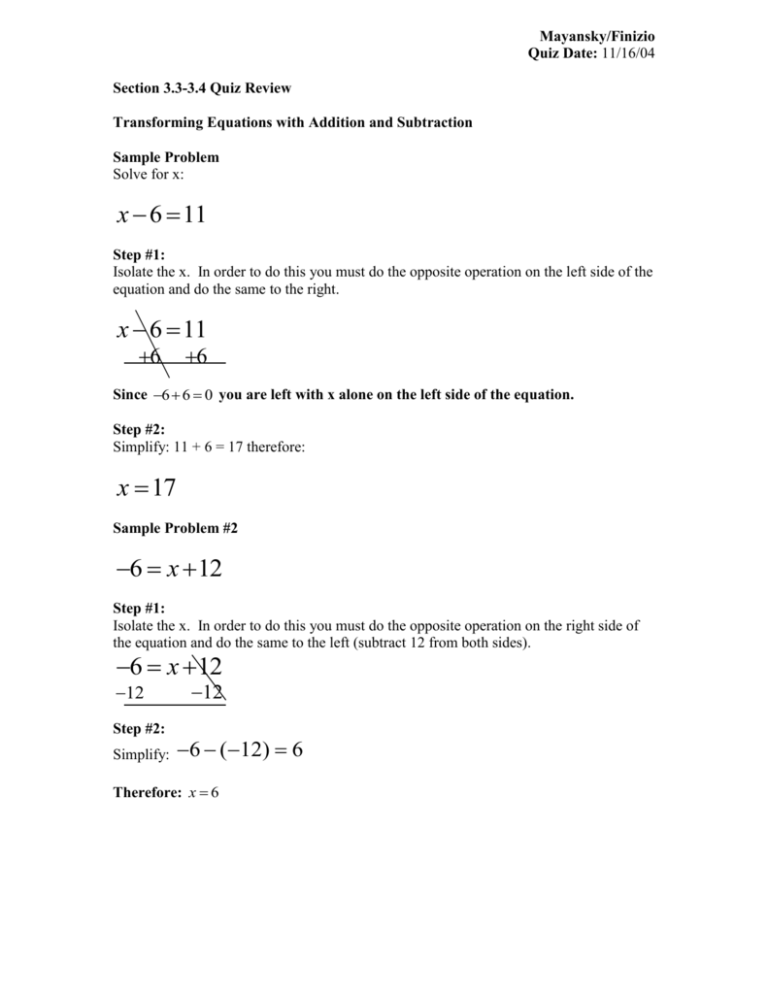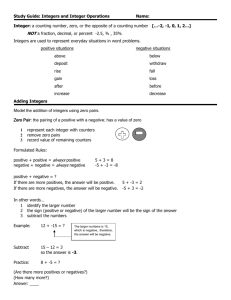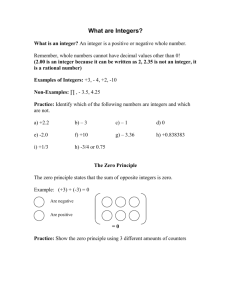Solving Equations Study Guide 2
advertisement

Mayansky/Finizio Quiz Date: 11/16/04 Section 3.3-3.4 Quiz Review Transforming Equations with Addition and Subtraction Sample Problem Solve for x: x 6 11 Step #1: Isolate the x. In order to do this you must do the opposite operation on the left side of the equation and do the same to the right. x 6 11 6 6 Since 6 6 0 you are left with x alone on the left side of the equation. Step #2: Simplify: 11 + 6 = 17 therefore: x 17 Sample Problem #2 6 x 12 Step #1: Isolate the x. In order to do this you must do the opposite operation on the right side of the equation and do the same to the left (subtract 12 from both sides). 6 x 12 12 Step #2: Simplify: 12 6 (12) 6 Therefore: x 6 Practice Problems: x 2 13 t 15 27 y 32 45 12 a 23 x 6 25 z 54 63 1.8 h 3.8 y 9 17 52 m 84 x 95 200 Transforming Equations with Multiplication and Division Sample Problem #1: 6x 222 Step #1: Isolate the x. In order to do this you must do the opposite operation on the left side of the equation and do the same on the right side. 6x 222 6 6 Step #2: Simplify: 222 6 37 Therefore: x 37 Sample Problem #2: 2 8 t 3 Step #1: The operation that is going on here is multiplication. You must do the opposite 2 operation to isolate the t. In order to do this you must divide by which is the same 3 3 thing as multiplying by . 2 3 3 2 8 t ( ) 2 2 3 Step #2: Simplify 12 t Therefore: 12 t Sample Problem #3: m 5 3 Step #1: The operation being performed in this equation is Division, therefore you must do multiplication to isolate the m. m 3 3 5 3 Step #2: Simplify m 5(3) Therefore: m 15 Practice Problems: 2 m6 3 3 y 15 7 5 x 40 7 4 y 20 5 c 24 6 y 25 5 28 c 7 1 1 b2 2 2 x 15 3 Section 3.3: Using Several Transformations: Sample Problem #1: 5n 9 71 Step #1: Isolate the term with the n. In order to do this you must get rid of the 9. In order to do this you must use the opposite operation, therefore you must first subtract 9 from both sides of the equation. 5n 6 71 6 6 5n 65 Step #2: Now you must isolate the n in this problem. In order to do this you must do the opposite operation and divide both sides of the equation by 5. 5n 65 5 5 Therefore: n 13 Sample Problem #2: w5 2 9 Step #1: 9 Isolate (w – 5) in order to do this you must first multiply both sides of the equation by . 1 9 w5 2 9 9 1 1 After you do this, you are left with: w 5 18 Step #2: Now you must isolate the w. In order to do this you must add 5 to both sides of the equation. w 5 18 5 5 w 23 Sample Problem #3 3(a 5) 19 2 Step #1: You must first get rid of the parenthesis on the left side of the equation. In order to do this you must distribute the 3. 3 a (3 5) Your New Equation is: 3a 15 19 2 Step #2: Combine Like Terms. In this equations you can combine 15 19 . Your New Equations is: 3a 4 2 Step #4: Isolate the term with “a.” In this case it is 3a. In order to do this you must subtract both sides of the equation by 4. 3a 4 2 4 4 3a 6 Step #5: Isolate “a.” In order to do this you must divide both sides of the equation by 3. 3a 6 3 3 Therefore: a 2 Practice Problems: 2 y 1 15 2 x 7 13 26 5 y 1 13 6 y 23 1 x3 5 2 x 7 1 2 x2 4 3 3 4( k 7) 15 2(b 8) 9 5 d 4( d 6) 1 3 7( h 2) 17 3 ( x 2) 12 5 7 3(t 5) t Word Problems: Writing Equations from Words and Solving Them (+) (-) (x) () Multiply Divide Times Divided by Add Subtract Plus Minus More Than Less Than Product of Divided into Sum of Difference Twice Quotient Increased By Decreased By Added To Subtracted From Multiplied By *Twice a Number = 2n 1 n *Half a Number = n or 2 2 Sample Problem #1: The sum of 38 and twice a number is 124. Find the Number. Step #1: Choose a variable to equal the “number.” Let “n” = the number. Step #2: Translate words into math symbols. Sum = Addition Twice a Number = 2n Step #3: Write the equation. 38 2n 124 Step #4: Solve for “n.” 38 2n 124 38 2n 86 2 2 38 n 43 Sample Problem #2: Six less than twice a number is 18. Find the number. Step #1: Write the Equation. **Remember if the equation says “less than” you must put that term second in the equation. Let “n”= the number 2n 6 18 Step #2: Solve for “n” 2n 6 18 6 6 2n 24 2 2 n 12 Sample Problem #3: The sum of two consecutive integers is 43. Find the integers. Step #1: Write the Equation x = The first consecutive integer. x + 1= The second consecutive integer. Therefore the equation you need to solve for this problem is: x ( x 1) 43 Step #2: Solve the Equation In order to solve this problem you must first combine your like terms. 2x 1 43 Step #3: Isolate the Term with X (subtract 1 from both sides of the equation) 2x 1 43 1 1 2x 42 Step #4: Isolate the X (divide both sides of the equation by 2) 2x 42 2 2 Therefore: x 21 Step #5 Find the integers. Since: x = The first consecutive integer. x + 1= The second consecutive integer The first integer is 21 and the second integer is 22. Practice Problems: 1. Five more than three times a number is 197. Find the number. 2. Four less than half of a number is 17. Find the number. 3. When one third of a number is decreased by 11, the result is 38. Find the number. 4. Eight less than three quarters of a number is 91. Find the number. 5. Four more than two thirds of a number is 22. Find the number. 6. The sum of two consecutive integers is 43. Find the integers. 7. The sum of four consecutive integers is -106. Find the integers. 8. The product of two consecutive integers is 47. Find the integers. 9. The sum of three consecutive integers is 24. Find the integers. 10. The sum of two consecutive integers is -103. Find the integers.






